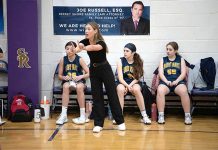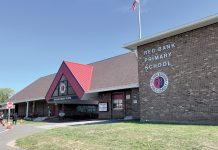
By Elizabeth Wulfhorst
LITTLE SILVER – The 2020-21 school year was never going to be easy, but one high school discovered how prepared it was to quickly adjust its hybrid learning model before the school doors even opened.
Students at Red Bank Regional were supposed to begin in-person classes Thursday, Sept. 10 for the first time since March, but a late delivery on a major part of the school’s COVID-19 safety plan had them pivoting to virtual learning with little advanced notice. Five walk-through temperature screening units that should have been delivered to the school by Sept. 5 didn’t arrive until Sept. 13.
Classes did start last Thursday, just remotely for everyone. “We can pivot pretty rapidly and seamlessly between different modes” of instruction, explained Louis Moore, superintendent of Red Bank Regional High School District. The first three days of the school year were all virtual, “but we were able to keep the flow going” because of prior planning, he said.
While the temperature screening units, which look a little like metal detectors, are light, easy to move and don’t require much more than a power source, Moore said the administration wanted to give staff a day to test the equipment. So on Tuesday, Sept. 15, around 600 students – about half the high school population – entered the front doors, got scanned and went on with their day.
Moore explained that the units have two sensors; as students and staff walk through the machine they either raise their arm “like you’re raising your hand in class” or turn their head. “The screening is incredibly fast,” he said, with at least 20 people screened per minute. School nurses are in front of the school to answer any questions and staff members monitor the screening units and ensure everyone is within a normal temperature range. Nurses are called to do a secondary temperature check with a handheld device for any positive or false readings. Students wait socially distanced on a marked line outside the school, but since buses arrive throughout the morning and there are three dedicated units for arriving students, that line never got very long, Moore said.
RBR will continue with a hybrid learning model for the foreseeable future. Students will be in school two days a week – half the students on Monday and Thursday, the other half on Tuesday and Friday – and learn remotely the other three days.

“Instructional time ends at around noon time, but the expectation is that students continue to do their work at home and put in a full school day” every day, Moore said. “They’ll be working independently but the teachers are available every day. Teachers are still here in the building.”
If COVID-19 numbers get better in the coming months, “We certainly have provisions to move toward a longer day with the cohorts in place, and then if things really get better, then we can have some pivot toward a normal schedule,” he said.
But right now things are still far from normal. Moore said he spoke with two seniors Tuesday morning who called the first day of school “weird” because of the lack of socialization. The school day ends before lunch which the district provides as a grab-and-go meal. “All those things that are part of the day that allow socialization, relaxation, it’s not happening by design,” he said. “Our priority is the instructional program when the kids are here.”
Moore said he hopes some normalcy will come once fall sports resume next month. “Our first football game is going to be in early October and we’re going to follow strict social distancing and other safe and healthy guidelines.” Tickets will be sold to games and only ticket holders will be allowed on campus. With a 500-person limit at outdoor athletic events dictated by state mandates, including players, coaches, cheerleaders, marching bands and of course, the opposing team, Moore said the bulk of tickets will go to students and family. “But it will just be good to have everyone together,” he said.
It may be premature to feel confident after one day back but, Moore said, “I’m really incredibly proud of my colleagues, of the students and our families for doing their part” to make the first day a success.
The article originally appeared in the September 17 – 23, 2020 print edition of The Two River Times.














